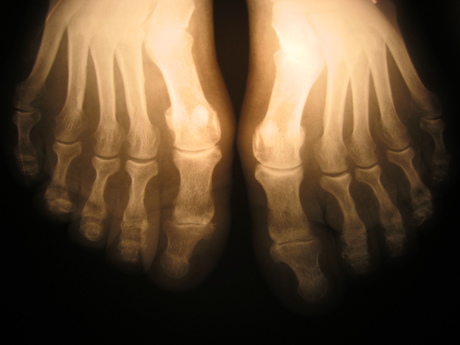High-res bone scans without the radiation

Irish researchers have devised a new scanning technique that produces high-resolution 3D images of bones without exposing patients to X-ray radiation. Published in the journal Chem, the method will be particularly suitable for people whose bones contain an accumulation of microdamage, such as those with stress or fragility fractures.
“Everyday activity loads our bones and causes microcracks to develop,” explained Professor Clive Lee, from the Royal College of Surgeons in Ireland (RCSI). “These are normally repaired by a remodelling process, but when microcracks develop faster, they can exceed the repair rate and so accumulate and weaken our bones.
“Current X-ray techniques can tell us about the quantity of bone present, but they do not give much information about bone quality.”
Seeking a solution, Professor Lee and his colleagues from Trinity College Dublin attached luminescent compounds to tiny gold structures to form biologically safe ‘nanoagents’ that are attracted to calcium-rich surfaces, which appear when bones crack — even at a micro level. These nanoagents target and highlight the cracks formed in bones, allowing researchers to produce a 3D image of the damaged regions.
“We can achieve a three-dimensional map of bone damage, showing the so-called microcracks, using non-invasive luminescence imaging,” said Professor Thorri Gunnlaugsson from Trinity. “The nanoagent we have developed allows us to visualise the nature and the extent of the damage in a manner that wasn’t previously possible.”
Professor Gunnlaugsson said the breakthrough marks “a major step forward in our endeavour to develop targeted contrast agents for bone diagnostics for use in clinical applications”. It should help prevent the need for bone implants in many cases and also act as an early-warning system for people at a high risk of degenerative bone diseases, such as osteoporosis.
“By using our new nanoagent to label microcracks and detecting them with magnetic resonance imaging (MRI), we hope to measure both bone quantity and quality and identify those at greatest risk of fracture and institute appropriate therapy,” he said. “Diagnosing weak bones before they break should therefore reduce the need for operations and implants — prevention is better than cure.”
Additionally, the imaging technique means patients will not be exposed to X-ray radiation, which has in some cases been associated with an increased risk of cancer. The gold-based nanoagents used in this alternative technique are biologically safe, with gold having been used safely by medics in the body for some time.
“These nanoagents have great potential for clinical application,” said Esther Surender, a postdoctoral researcher at Trinity. “Firstly, by using gold nanoparticles, we were able to lower the overall concentration of the agent that would have to be administered within the body, which is ideal from a clinical perspective. Secondly, by using what is called ‘two-photon excitation’ we were able to image bone structure using long wavelength excitation, which is not harmful or damaging to biological tissues.
“These nanoagents are similar to the contrast agents that are currently being utilised for MRI within the clinic, and hence have the potential to provide a novel means of medical bone diagnosis in the future,” Surender added. “Specifically, by replacing the europium with its sister ion gadolinium, we can tune into the MRI activity of these nanoagents for future use alongside X-ray and computed tomography (CT) scans.”
Revealed: the complex composition of Sydney's beach blobs
Scientists have made significant progress in understanding the composition of the mysterious...
Sensitive gas measurement with a new spectroscopy technique
'Free-form dual-comb spectroscopy' offers a faster, more flexible and more sensitive way...
The chemistry of Sydney's 'tar balls' explained
The arrival of hundreds of tar balls — dark, spherical, sticky blobs formed from weathered...




